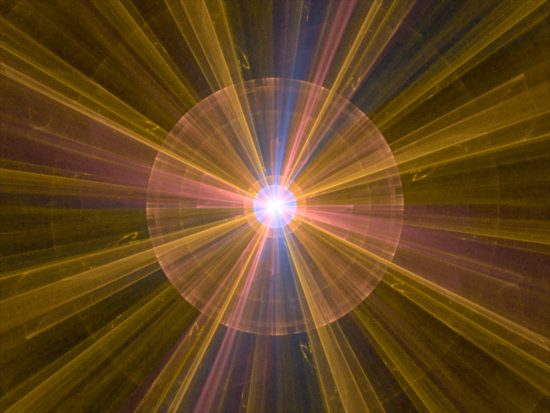
“Hypernova”. Image by Stephen Smith.
Nov 7, 2016
Electricity in space explains anomalous energy curves.
Cosmologists often find it difficult to reconcile theory with observation. So-called “gamma-ray bursts” (GRB) are a case in point. GRBs were discovered first in galaxies with high redshift—some seeming to be 12 billion light-years away. If they are that far away, the energies observed are beyond any supernova explosion. “Hypernova” were created out of the data, in an attempt to salvage “redshift-indicates-distance” theory.
Of the three types of natural radioactivity, gamma rays are the most energetic, with values 10^15 times greater than visible light. They also have short wavelengths, less than 0.1 nanometers, in some instances. Since gamma-rays are capable of penetrating interstitial atomic spaces, gamma-ray detectors depend on ionization of a crystalline matrix, causing it to emit electrons through a process known as Compton scattering. It is the electrons that are seen and not gamma-rays, themselves.
Astrophysicists describe GRBs as the merging of neutron stars or the high frequency light radiating from powerful hypernova explosions. Conventionally, shockwaves propagating outward are thought to apply kinetic energy forces to electrons. However, astronomers found GRBs sometimes behave in ways that are unexpected. If redshift measurements are inaccurate, perhaps the estimated size of gamma-ray bursts is off, so what does that mean for GRB measurements?
Computer simulations reveal that plasma phenomena can be scaled over many orders of magnitude—they behave in the same way whether in atoms or galaxies. Perhaps GRBs are really flashes of cosmic lightning erupting from immense, electrified clouds of plasma.
When charged particles are accelerated in an electric field, they emit synchrotron radiation that creates X-rays and gamma-rays—something that has been demonstrated in laboratory experiments. Gamma-rays are a class of theoretical “electromagnetic particles” called photons. Photons are “massless,” as astrophysicists define mass, but since they travel at enormous velocity (up to 2.993 x 10^10 centimeters per second), so-called “relativistic effects” come into play. That high velocity increases their inertia, enough for them to knock electrons out of an atom.
Electric Universe cosmologists postulate that GRB intensity, measured via redshift correlation, is not correct. GRBs are actually occurring in nearby galactic neighborhoods, so they are not unimaginably powerful, and not coming from the edge the Universe. If GRBs are located nearby, they are less energetic and plasma discharges in the form of exploding double layers can accelerate photons in ways that can be explored though laboratory experiments. Rather than relying on mathematical phantoms like hypernovae, why not create testable hypotheses and work them up with physical models?
As has been noted in the past, Hannes Alfvén thought that the “exploding double layer” should be considered a new class of celestial object. Z-pinches in plasma filaments create plasmoids that evolve into stars and galaxies. Electricity is responsible for the birth of stars, and when the current density gets too high, double layers in the circuit catastrophically release their excess energy, appearing as GRBs, X-rays, or flares of ultraviolet light.
“From what has been said it is obvious that astrophysics runs the risk of getting too speculative, unless it tries very hard to keep contact with laboratory physics. Indeed it is essential to stress that astrophysics is essentially an application to cosmic phenomena of the laws of nature found in the laboratory. From this follows that a particular field of astrophysics is not ripe for a scientific approach before experimental physics has reached a certain state of development.”
— Hannes Alfvén
Stephen Smith












